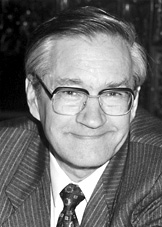- The Nobel Prize in Chemistry 1991
- Richard R. Ernst
-
The Nobel Prize in Chemistry 1991 was awarded to Richard R. Ernst "for his contributions to the development of the methodology of high resolution nuclear magnetic resonance (NMR) spectroscopy".
In the late 1940s, Felix Bloch and Edward Purcell discovered NMR, a method that manipulates the weak magnetic spin of subatomic particles with magnetic fields and radio waves in a way that unmasks the identity of the atoms in which they reside. When Ernst entered the field in the late 1950s, NMR was an interesting tool, though its low sensitivity and the need for large samples made it far from being the method of choice to solve complicated chemical structures.
Ernst's revolutionary answer to the problem was to retune the traditional method for obtaining NMR signals. Researchers could now use hundreds of pulses in the time taken to obtain a single slow sweep, and combining the signals from these pulses increased the sensitivity of NMR dramatically. This brought NMR into a new age, in which it finally became possible to detect weak, inaudible notes produced by small amounts of material, or from elements with magnetic nuclei that are rare in nature. Ernst's other major development was to devise a way of striking nuclei with a sequence of two or more pulses at varying time intervals. The time between pulses allowed interactions between adjacent nuclei in the molecule to evolve before being hit with another pulse. This so-called added dimension in radiofrequency made it possible to discover, among other things, which atoms were close in space to each other in a molecule.

Richard R. Ernst
-
Health and Chemical more >
-
Hot Products
- 4045-51-6 1,3-Cyclopentadiene, 2,3-dimethyl-
- 79964-12-8 2-Propenoic acid, 2-methyl-, 3-butenyl ester
- 611-74-5 Benzamide,N,N-dimethyl-
- 1849-18-9 2,4-DI-SEC-BUTYLPHENOL
- 7719-09-7 Thionyl chloride
- 115118-68-8 Diisopropyl 3,3-dimethoxycyclobutane-1,1-dicarboxylate
- 102-52-3 1,1,3,3-Tetramethoxypropane
- 197304-01-1 Glycyrrhiza flavonol A
- 107-88-0 1,3-Butanediol
- 253265-97-3 Carbonic acid,2,5-dioxo-1-pyrrolidinyl [(3R,3aS,6aR)-hexahydrofuro[2,3-b]furan-3-yl] ester
- 105-13-5 Anisic alcohol
- 6358-69-6 Solvent Green 7


